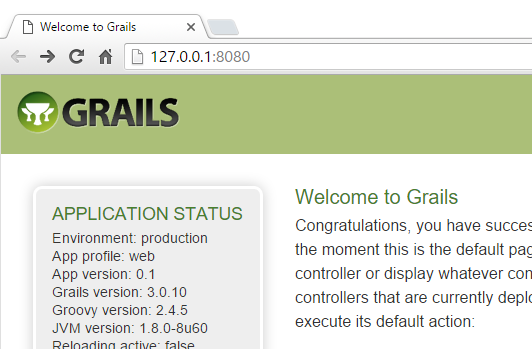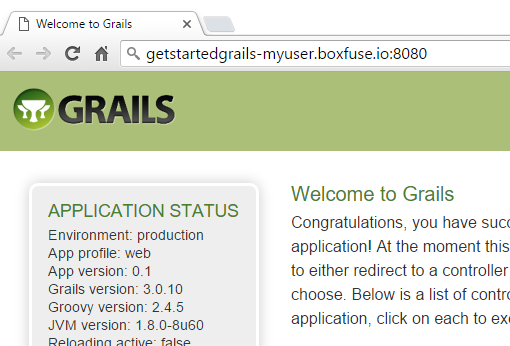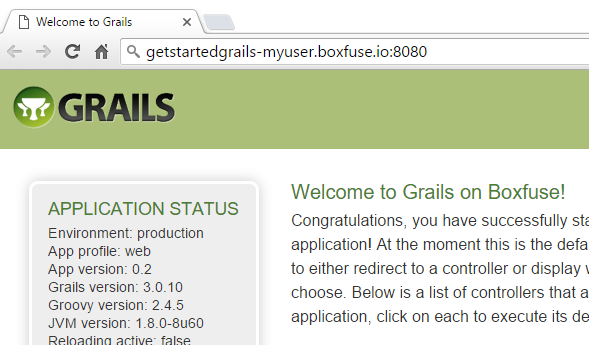Get Started with CloudCaptain & Grails

This tutorial will get you started with CloudCaptain and Grails. It should take you about 5-10 minutes to complete.
Prerequisites
Before you begin, ensure you have successfully:
- created a CloudCaptain Account (simply log in with your GitHub account, it's free)
- downloaded and installed the latest CloudCaptain Client
- downloaded and installed the latest version of VirtualBox
- downloaded and installed the latest JDK with
JAVA_HOMEset up correctly - downloaded and installed the latest version of Grails with
GRAILS_HOMEset up correctly
Creating the Grails application
Creating a new Grails app is incredibly easy. All you need is:
> grails create-app getstarted-grails
Once that's done, you will have the following structure:
getstarted-grails
gradle
grails-app
assets
conf
spring
application.yml
logback.groovy
controllers
domain
i18n
init
services
taglib
utils
views
src
main
groovy
webapp
test
groovy
integration-test
groovy
.gitignore
build.gradle
gradle.properties
gradlew
gradlew.bat
Your application is now fully set up. As your skeleton also includes Spring Boot's actuator (Spring Boot's turn-key production readiness features), you now have two urls available:
/: your controller/health: Spring Boot actuator's health check page
Go ahead and build it:
getstarted-grails> grails war
Great. Your Grails application is now available under build/libs/getstarted-grails-0.1.jar.
Fusing a CloudCaptain image and running it locally on VirtualBox
Now it's time to fuse your application into a CloudCaptain image and launch an instance of it on VirtualBox:
getstarted-grails> boxfuse run
Fusing Image for getstarted-grails-0.1.jar ...
Image fused in 00:10.089s (97828 K) -> myuser/getstarted-grails:0.1
Launching Instance of myuser/getstarted-grails:0.1 on VirtualBox ...
Forwarding http port localhost:8080 -> vb-9feb5d7c:8080
Instance launched in 00:04.688s -> vb-9feb5d7c
Waiting for Payload to start on Instance vb-9feb5d7c ...
Payload started in 00:06.029s -> https://127.0.0.1:8080
CloudCaptain has automatically detected the Spring Boot Actuator and used the /health endpoint to check whether the instance came up correctly.
Open a browser at this address to see your new application up and running within the VirtualBox VM by simply executing:
getstarted-grails> boxfuse open

You can also see your newly created image:
getstarted-grails> boxfuse ls
Images available locally:
+------------------------------+---------------------------+-------+---------+-----------+--------------+---------+---------------------+
| Image | Payload | Debug | Java | AppServer | Ports | Size | Generated at |
+------------------------------+---------------------------+-------+---------+-----------+--------------+---------+---------------------+
| myuser/getstarted-grails:0.1 | getstarted-grails-0.1.jar | false | 8.60.22 | Grails | http -> 8080 | 97828 K | 2015-12-21 17:47:50 |
+------------------------------+---------------------------+-------+---------+-----------+--------------+---------+---------------------+
Total: 1
As well as the instance that is running:
getstarted-grails> boxfuse ps
Running Instances on VirtualBox in the dev environment :
+-------------+------------------------------+---------------------+-----------------------+---------------------+
| Instance | Image | Type | URL | Launched at |
+-------------+------------------------------+---------------------+-----------------------+---------------------+
| vb-9feb5d7c | myuser/getstarted-grails:0.1 | 4 CPU / 1024 MB RAM | https://127.0.0.1:8080 | 2015-12-21 17:47:56 |
+-------------+------------------------------+---------------------+-----------------------+---------------------+
Total: 1
Deploying your application to AWS
Now let's deploy the image to AWS. As CloudCaptain works with your AWS account, it first needs the necessary permissions to do so. So if you haven't already done it, go to the CloudCaptain Console and connect your AWS account now.
Every new CloudCaptain account comes with 3 environments: dev, test and prod.
dev is your local VirtualBox environment and test and prod are on AWS.
So let's deploy our application to the prod environment on AWS:
getstarted-grails> boxfuse run -env=prodCreating myuser/getstarted-grails ... Pushing myuser/getstarted-grails:0.1 ... Verifying myuser/getstarted-grails:0.1 ... Waiting for AWS to create an AMI for myuser/getstarted-grails:0.1 in eu-central-1 (this may take up to 50 seconds) ... AMI created in 00:19.095s in eu-central-1 -> ami-fd5b4491 Creating Elastic IP ... Mapping getstartedgrails-myuser.boxfuse.io to 52.29.77.147 ... Creating security group boxsg-myuser-prod-getstarted-grails-0.1 ... Launching t2.micro instance of myuser/getstarted-grails:0.1 (ami-fd5b4491) in prod (eu-central-1) ... Instance launched in 00:50.707s -> i-2c1daf90 Waiting for AWS to boot Instance i-2c1daf90 and Payload to start at https://52.59.247.126:8080/health ... Payload started in 00:55.567s -> https://52.59.247.126:8080/health Remapping Elastic IP 52.29.77.147 to i-2c1daf90 ... Waiting 15s for AWS to complete Elastic IP Zero Downtime transition ... Deployment completed successfully. myuser/getstarted-grails:0.1 is up and running at https://getstartedgrails-myuser.boxfuse.io:8080/
Notice that CloudCaptain has reused your image unchanged instead fusing a new one.
With that one command CloudCaptain has automatically pushed your image to the CloudCaptain Vault as well as provisioned, configured and secured all necessary AWS resources. There is no manual work necessary on your behalf.
All you need to do is simply navigate to your new domain to see your Spring Boot application in action on AWS:

Bonus: update your application with zero downtime
Now let's take things one step further and deploy an update of your application with zero downtime using blue/green deployments.
Start by modifying grails-app/views/index.gsp and change the title:
<h1>Welcome to Grails on CloudCaptain!</h1>
then bump the version in build.gradle:
version "0.2"
and rebuild the jar:
getstarted-grails> grails clean
getstarted-grails> grails war
Finally deploy the new version of your application to AWS:
getstarted-grails> boxfuse run -env=prodFusing Image for getstarted-grails-0.2.jar ... Image fused in 00:10.048s (97827 K) -> myuser/getstarted-grails:0.2 Pushing myuser/getstarted-grails:0.2 ... Verifying myuser/getstarted-grails:0.2 ... Waiting for AWS to create an AMI for myuser/getstarted-grails:0.2 in eu-central-1 (this may take up to 50 seconds) ... AMI created in 00:18.013s in eu-central-1 -> ami-7b5a4517 Creating security group boxsg-myuser-prod-getstarted-grails-0.2 ... Launching t2.micro instance of myuser/getstarted-grails:0.2 (ami-7b5a4517) in prod (eu-central-1) ... Instance launched in 00:41.174s -> i-b502b009 Waiting for AWS to boot Instance i-b502b009 and Payload to start at https://52.59.254.138:8080/health ... Payload started in 01:27.645s -> https://52.59.254.138:8080/health Remapping Elastic IP 52.29.77.147 to i-b502b009 ... Waiting 15s for AWS to complete Elastic IP Zero Downtime transition ... Terminating instance i-2c1daf90 ... Destroying Security Group sg-5981cb30 ... Deployment completed successfully. myuser/getstarted-grails:0.2 is up and running at https://getstartedgrails-myuser.boxfuse.io:8080/
And there it is:

Summary
In this brief guide we have seen how to:
- create a Grails application
- fuse it into a CloudCaptain image
- deploy the image locally on VirtualBox
- deploy the image unchanged to AWS
- update the application with zero downtime
Now it's your turn. Take your favorite Grails application and deploy it with ease and pleasure.
And don't forget, CloudCaptain also comes with a Gradle plugin to seamlessly integrate with your CI/CD workflow.
